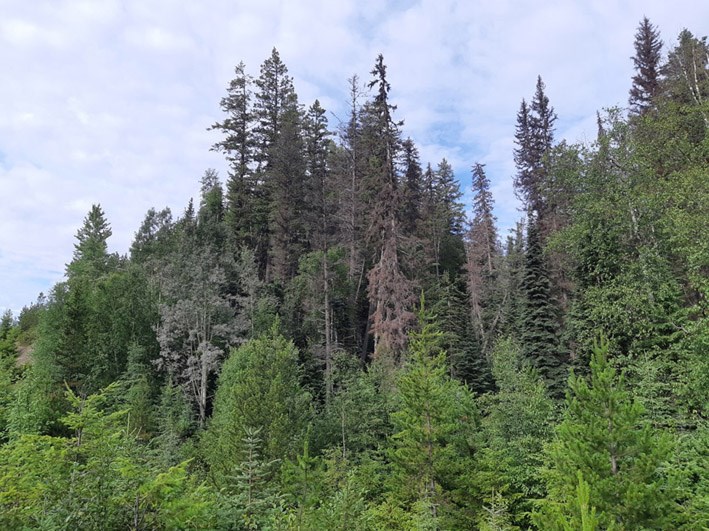The region's forests are facing another beetle threat.
The spruce beetle's spread throughout area forests during the past six years has been massive.
In 2013, 7,653 hectares of forest in B.C. were affected by the spruce beetle. Last year, there was more than 503,799 hectares impacted across the province and more than half of that was in this area.
The Prince George district saw 259,629 hectares of forest hit by the spruce beetle while the Omineca Region, which includes Prince George, Fort St. James, Mackenzie, and Vanderhoof, reported more than 354,000 hectares of damage.
Since 2014, a total of 1.3 million hectares have been impacted in the province, making it
the biggest outbreak of spruce beetle infestation since the 1980s.
The spruce beetle, which is endemic to the B.C. forest, prefers to attack old growth trees so as people travel to areas around Prince George like the Tacheeda Lakes area north of Bear Lake, sections of red can be seen in stands of trees that are heavily populated with spruce.
Spruce tree stands are not like pine forests. There is significant secondary growth in a spruce stand of trees. Look below the tall spruce in a stand to see a diverse stand of trees of all ages that include balsam, pine fir, hemlock and spruce growing together.
"I know it looks devastating when you're flying over it but there's a lot more alive in a spruce forest," John Pousette, director for the Provincial Bark Beetle Response who was appointed to coordinate response efforts across the province, said. "There's a significant amount of live trees in the understory of a spruce stand. So we want to make sure we're prioritizing the stands with the most dead trees and not necessarily taking stands that will rebound and recover."
Gone are the days when clear cutting is the only answer to mitigate a beetle infestation, like what was used years ago to target the pine beetle.
There are a variety of ways to mitigate spruce beetle damage, starting with conducting ground and aerial surveys, doing single tree treatments of conventional trap trees, and more aggressive methods like fall and burn, fall and peel, pheromone baiting, sanitation/salvage harvesting, hazard and risk rating and high hazard removal.
Every year, plans are updated after an evaluation to consider the latest in monitoring.
As far as controlling the spruce beetle infestation, the government is relying on harvesting while taking extra care to keep the unaffected portion of the forest intact.
"We're surveying for red attack," Pousette said. "We're flying in helicopters and airplanes and we're doing a systematic survey to find where the current red is because as a tree gets attacked it generally turns red just like the pine beetle. When we see red we know where the live beetles are and where they're laying eggs."
That's where harvesting takes place and the affected trees are brought to the mill.
"In the process we get rid of the beetle," Pousette said. "We're doing a significant amount of salvage right now because this thing's been going on since 2014."
Research in the Omenica Region's Forest Health Strategy 2018-2019 suggests the outbreak occurred because Prince George and Mackenzie have experienced warmer spring and summer temperatures since 2014.
Those warmer temperatures together with reduced precipitation and trees are uprooted due to wind have seen the spruce beetle thrive as they prefer downed trees to standing trees. When populations of the spruce beetle are great, like they are now, the beetle will attack live trees.
"They are everywhere and they're normally knocked back by cold temperatures but since temperatures haven't been that cold those populations start to grow and that's one of our biggest issues," Pousette said.
If there was large concentrations of the beetle in a certain area, it would be a different circumstance where efforts to mitigate could be targeted but because the beetle is everywhere it makes planned mitigation a challenge.
To let nature take its course there needs to be a prolonged period of cold temperatures to kill the spruce beetle.
"The 40 below temperatures we had for a short time last winter wasn't long enough," Pousette said. "We need an extended period of cold."
Pousette said about a week should do the trick.
In the meantime forest ministry staff continue to work with major licensees to develop and execute plans and management practices that sees targeted pest reduction harvesting of spruce-beetle infested stands and hauling and milling strategies that will effectively reduce population spread.



